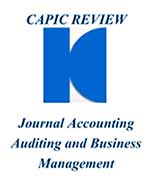Monitoring of Corporate Governance Code in Argentina: The Control Environment Dimension
Published 2024-05-17
Keywords
- external audit,
- internal audit,
- Argentinean companies,
- corporate governance,
- business monitoring
How to Cite
Copyright (c) 2024 Anahi Briozzo, Diana Albanese, Eliana Barco

This work is licensed under a Creative Commons Attribution-NonCommercial-ShareAlike 4.0 International License.
Abstract
Two main conceptual frameworks sustain the study of the implementation of corporate governance codes (CGCs) by companies: the efficiency approach (encompassing agency theory, signaling, and stakeholder view) and institutional theory. The aim is to analyze the practices in the control environment dimension as reported in the CGC for those companies randomly monitored by the National Securities Commission (NSC) in Argentina. Firstly, the application of practices related to internal and external auditing is examined. Subsequently, the changes introduced in this dimension since the initial implementation of control in 2020 are identified.
A qualitative study based on document analysis is conducted, taking as case studies the eight randomly selected companies in 2020 whose CGC reporting was subject to three consecutive years of monitoring by the NSC. We use the content analysis technique, identifying five categories of analysis: i) integrated risk management system, ii) internal audit, iii) annual risk-based audit plan, iv) audit committee, and v) selection and monitoring policy for external auditors.
The results reveal high heterogeneity in the application of practices, irrespective of the type of issuer. The temporal evolution of disclosed information shows partial improvement in quality, as even after the monitoring period, there are still practices that are not reported and explanations lacking informative content.
Downloads
References
- Aguilera, R. V., & Cuervo‐Cazurra, A. (2009). Codes of good governance. Corporate Governance: An International Review, 17(3), 376-387. doi:10.1111/j.1467-8683.2009.00737.x
- Barco, E., & Briozzo, A. (2020). Código de Gobierno Societario en la Argentina: análisis del nivel de cumplimiento. RETOS. Revista de Ciencias de la Administración y Economía, 10(19), 45-63. doi: 10.17163/ret.n19.2020.03
- Aluchna, M., & Kuszewski, T. (2022). Responses to corporate governance code: evidence from a longitudinal study. Review of Managerial Science, 16(6), 1945-1978. doi:10.1007/s11846-021-00496-3
- Comisión Nacional de Valores (2007). Resolución General 516/2007. Código de Gobierno Societario. Recuperado de: https://www.argentina.gob.ar/normativa/nacional/resoluci%C3%B3n-516-2007-133520/texto
- Comisión Nacional de Valores (2012). Resolución General 606/2012. Modificación Normas CNV (N.T. 2001) – Código de Gobierno Societario. Recuperado de: https://servicios.infoleg.gob.ar/infolegInternet/anexos/195000-199999/198057/norma.htm
- Comisión Nacional de Valores (2019). Resolución General 797/2019. Normas (N.T. 2013 y mod.). Modificación. Código de Gobierno Societario. Recuperado de:
- Comisión Nacional de Valores (2022). Recomendaciones para el reporte del CGS. Recuperado de https://www.argentina.gob.ar/sites/default/files/recomendaciones_para_el_reporte_del_cgs209_1.pdf.
- Freeman, R. E. (1984). Strategic Management: A Stakeholder Approach. Editorial Pitman. Boston.
- Ley 26.831. Mercado de Capitales. Boletín Oficial de la Nación Argentina, Buenos Aires, Argentina, 27 de diciembre de 2012.
- Manzanares, M. D., & Leal, R. P. (2020). The first year of mandatory comply-or-explain in Brazil. Latin American Business Review, 22(1), 1-32. doi: 10.1080/10978526.2020.1749844
- Seidl, D., Sanderson, P., & Roberts, J. (2013). Applying the ‘comply-or-explain’principle: discursive legitimacy tactics with regard to codes of corporate governance. Journal of Management & Governance, 17, 791-826. doi: 10.1007/s10997-011-9209-y
- Shrives, P. J., & Brennan, N. M. (2015). A typology for exploring the quality of explanations for non-compliance with UK corporate governance regulations. The British Accounting Review, http://dx.doi.org/10.1016/j.bar.2014.08.002
- Shrives, P. J., & Brennan, N. M. (2017). Explanations for corporate governance non-compliance: A rhetorical analysis. Critical Perspectives on Accounting, 49, 31-56. doi: 10.1016/j.cpa.2017.08.003
- Thanasas, G. L., Kontogeorga, G., & Drogalas, G. A. (2018). Does the “capstone” of the “comply or explain” system work in practice? Evidence from Athens Stock Exchange. Corporate Governance: The International Journal of Business in Society, 18(5), 911-930. doi: 10.1108/CG-10-2017-0239


































